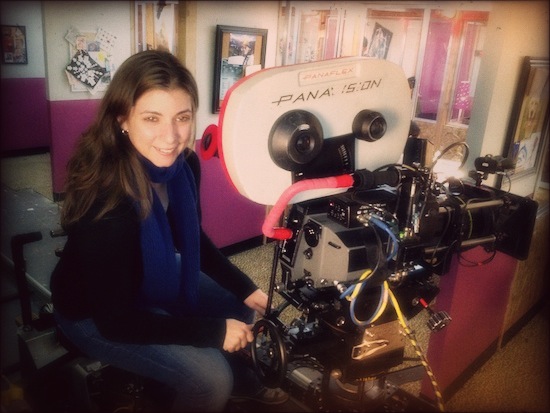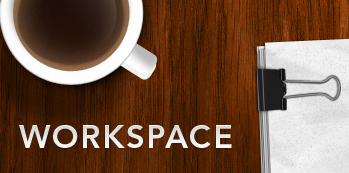
Who are you and what do you write?
My name is Christine Boylan. Most of my day is spent writing and producing television — I started on Leverage (TNT), worked on the sweet but never aired alien invasion series Day One (NBC), then Off the Map at ABC and now I’m a co-producer on Castle.
I occasionally write short stories (such as Hoss at Popcorn Fiction) and plays. I’ve also written comic books for DC, Marvel, Boom, Tokyopop and NBC, including two of the Heroes comics.
On the Twitter, I’m @kitmoxie.
Where and when do you write?
 Most of the time I write in my home office, which is a stone’s throw away from my husband’s office, but, luckily for him, we have doors.
Most of the time I write in my home office, which is a stone’s throw away from my husband’s office, but, luckily for him, we have doors.
I can write anywhere if I can get the spirit to move me (or I have a heart-stopping deadline) — passenger seat of cars (no motion sickness), trains, planes (usually drunk), the middle of the jungle, etc.
I try to change locations during a long writing session to keep myself going — this might be as simple as moving up to the kitchen and sitting on the annoying bench that hurts my back but keeps me awake, or it might mean just lying on the floor in some kind of weird cobra-pose for an hour and writing there. My office has a giant wood desk that’s more like a table than a desk. I alternate using two different chairs: an Aeron I stole from my husband when I moved in and a Swopper.
I had spine surgery when I was younger, so I try to move around and change positions as much as I can. I have yoga blocks and a foam roller, too. Also, a heating pad. And Vicodin. It’s a back-friendly office.
If left to my own devices, I’m a night person. When I was unemployed and writing my first spec pilot, I would sleep until noon, run errands, and then settle down to write from about 4pm to 8, then break, then 10pm to 4am. That was a very special, very Scotch-driven time in my career.
Now that I’m employed, I find that every TV writers’ room has its own culture and rules, so I adjust my schedule to theirs when the season starts.
John Rogers (@jonrog1) at Leverage is a productivity nerd, so he likes to use his writing staff to try out new processes. A lot of what we did there has stuck with me: working on a story for 48 minutes, then resting for 12. That one’s inviolable. You can’t fool around too much during a 48, you can’t discuss work on a 12. If caught, John would stop you — “Respect the 12!” — thus inculcating the idea of an earned rest period.
Speaking of rest, Mark Waid (@MarkWaid) taught me the value of walking away for a few hours and letting something simmer. If I’ve put in the time, then sleep, then I shower or take a yoga class, an idea will come. Maybe the idea is for the next project, but hell, it’s an idea, and I’ll have it happily.
This has been my schedule since June: I’ll get up at 7, head to the gym for swimming or yoga, then to the Castle offices in Hollywood. We run writers’ rooms all day, usually 10 to 7, and we often have two going at once. Then in the evening I’ll spend two or three hours working on one of my own projects or, if I’m burned for the day, have a drink and watch TV or read.
Weekends are exercise, writing in the afternoons, socializing. If I really need to get a personal project done, I’ll get a hotel room in Malibu or Palm Springs and marathon — room service is very, very helpful.
What hardware do you use?
I have a Macbook Pro at home and on the road, and I sometimes use the desktop Mac provided for me at the Castle offices. If I want a little extra crunch or manual exercise, I’ll hook up the Das Keyboard recommended to me by the lovely and talented Leverage writer M. Scott Veach (@mscottveach).
I use an iPad (first gen) for reading scripts and some books (GoodReader and Kindle for iPad, respectively) and watching shows on Netflix or the beautiful HBO Go. I have in the past written entire first draft outlines on my iPhone while on set. (I love being on set. Everyone knows what his or her job is. Boundaries are such a relief sometimes.)
I use index cards — something else I picked up at Leverage — to break story. I have cork squares on an entire wall of my home office, and it’s a nice, big wall space useful for everything from pilots to plays to features. We use white boards at Castle, which I admit I still dislike. I have the distinction of having really terrible handwriting on the board. 
What software do you use?
I handwrite my first drafts, which drives some of my colleagues crazy. I don’t know if it’s advantageous or not, but it’s just how my brain works. It’s good to be away from the computer (though I may use the dictionary/thesaurus on the phone or iPad); it’s good to feel the pen in your hand (I use a Libelle fountain pen, because the nib forces me to hold the pen correctly and not hurt my hand); it’s great to see the legal pads (letter sized) stacked up, full of scenes. They may be terrible, they may be marvelous, but they exist, and now you can rewrite them.
So then I type it all up — I use tall document holders from Fellowes (one at home, one at Castle) and I rewrite and edit to an extent while I’m typing that first draft. Then I print and go through it with the red or green pen — the pilot G2 works great. (I can’t stand ball points. Using one feels like scratching nails on a chalk board.) Then I re-type the changes.
If I’m in a real hurry — and on Leverage I had to write the first draft of one episode in a weekend — I’ll get someone in and dictate the script. My gorgeous friend Alex Engel can use all the software and can also read my mind. Unfortunately, he’s now a working writer and I can no longer take advantage of him for long dictation sessions. Sometimes I’ll dictate the boards in the writers’ room to our writers’ assistant at Castle, Adam Frost, and it ends up becoming a rough draft for the outline. Whether I dictate the script or not, I always have a step in the process where I read it through out loud.
Some people are visual, but I’m predominantly aural. I can hear if it’s wrong faster than I can see it.
For software, I use whatever the show uses. My first three shows used Movie Magic Screenwriter, and I still use it for comic books and stage plays. Castle uses Final Draft, which I hadn’t picked up in four years, but I’m getting used to it again.
None of these programs feels particularly elegant to me, though. Hand writing helps me avoid any software frustration early in the process, so by the time I’m typing I feel enough urgency to learn the damn keyboard shortcut and move forward.
For notes and research archives I use Evernote. I don’t know how I ever got along without it…except I do, and the evidence is scraps of paper in project-specific piles all over my office floor.
For organization purposes I swing insanely between orthodox GTD and total chaos, but I’ve been through Things and OmniFocus and now I use 3×5 cards in a Levenger Circa PDA.
Sometimes I listen to music when I’m working, usually something without lyrics unless I’m desperately trying to evoke a tone. Then I can put the same song on repeat for a few hours. Otherwise white noise apps are great (I listened to a lot of Amazon jungle sounds while writing Off the Map), and a good, solid metronome helps me find rhythm.
What would you change about how you write?
I would eliminate some of the self-loathing that takes up a lot of the energy I need to write. Procrastination is both useful and deadly. Again, if I’m stuck on a problem and I go away for four hours to ride horses, I’ll come back with a solution and I can get to work. But if I’ve procrastinated all weekend and then my time is up, I’m going to go to bed unhappy and have five miserable wake-ups in the week ahead.
I’m a huge fan of Steven Pressfield’s The War of Art – I have it on my Kindle, I keep a copy on my desk at home, I have an audio version on my iPod. Those lessons unfold themselves every day.
A really good friend of mine, Jacob Krueger, instills some of this stuff in his screenwriting classes, acting classes and hypnosis sessions in New York. It’s not about removing blocks per se, but about embracing the part of yourself that puts up those blocks.
Or maybe it’s about needing another Scotch.